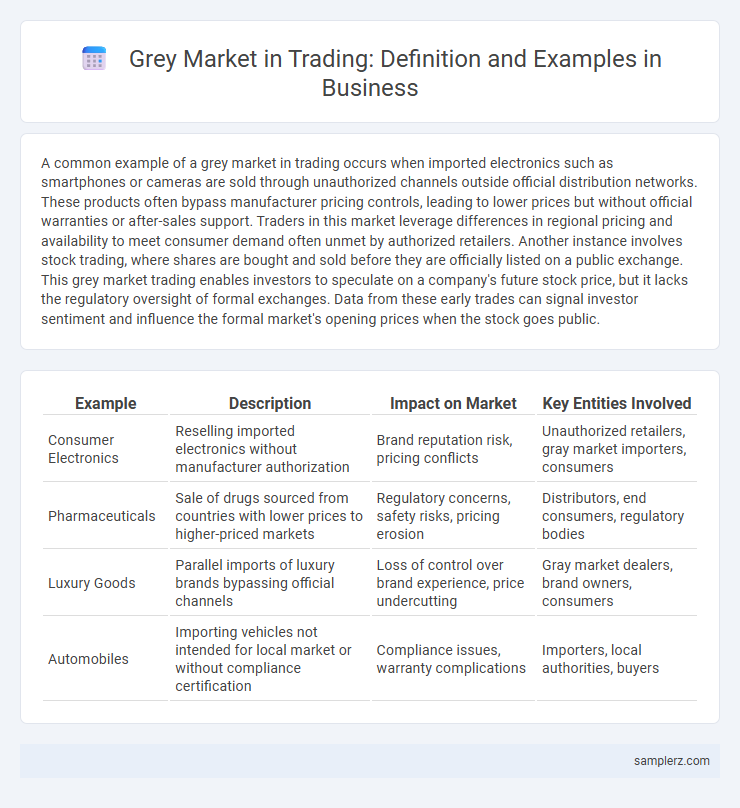A common example of a grey market in trading occurs when imported electronics such as smartphones or cameras are sold through unauthorized channels outside official distribution networks. These products often bypass manufacturer pricing controls, leading to lower prices but without official warranties or after-sales support. Traders in this market leverage differences in regional pricing and availability to meet consumer demand often unmet by authorized retailers. Another instance involves stock trading, where shares are bought and sold before they are officially listed on a public exchange. This grey market trading enables investors to speculate on a company's future stock price, but it lacks the regulatory oversight of formal exchanges. Data from these early trades can signal investor sentiment and influence the formal market's opening prices when the stock goes public.
Table of Comparison
| Example | Description | Impact on Market | Key Entities Involved |
|---|---|---|---|
| Consumer Electronics | Reselling imported electronics without manufacturer authorization | Brand reputation risk, pricing conflicts | Unauthorized retailers, gray market importers, consumers |
| Pharmaceuticals | Sale of drugs sourced from countries with lower prices to higher-priced markets | Regulatory concerns, safety risks, pricing erosion | Distributors, end consumers, regulatory bodies |
| Luxury Goods | Parallel imports of luxury brands bypassing official channels | Loss of control over brand experience, price undercutting | Gray market dealers, brand owners, consumers |
| Automobiles | Importing vehicles not intended for local market or without compliance certification | Compliance issues, warranty complications | Importers, local authorities, buyers |
Understanding the Grey Market in Trading
Grey market trading involves the purchase and sale of securities or goods through unofficial or unauthorized channels, often before official listings or releases. For instance, stocks of newly issued initial public offerings (IPOs) might be traded in the grey market prior to their formal market debut, allowing investors to speculate on pricing and demand. Understanding grey market dynamics helps traders assess potential risks and price discrepancies due to the absence of regulatory oversight.
Key Characteristics of Grey Market Transactions
Grey market transactions in business trading typically involve the sale of genuine products through unauthorized channels outside official distribution networks. Key characteristics include pricing that significantly undercuts authorized markets, absence of manufacturer warranties, and potential legal risks due to bypassing established supply chains. These transactions often occur with high-demand electronics, luxury goods, and pharmaceuticals, impacting brand value and authorized dealer revenues.
Popular Industries Affected by Grey Market Trading
The electronics industry is heavily impacted by grey market trading, where unauthorized dealers sell genuine products outside official channels, often undermining manufacturer pricing and warranties. The automotive sector also faces significant challenges, with vehicles imported and sold through unofficial networks, affecting authorized dealers and brand reputations. Furthermore, pharmaceuticals experience grey market activities that compromise drug safety and regulatory compliance, posing risks to consumers and legitimate businesses.
Real-World Examples of Grey Market Activities
In the business sector, grey market activities often involve the unauthorized sale of goods, such as electronics or pharmaceuticals, outside official distribution channels, impacting pricing and warranties. An example includes the importation of smartphones from regions with lower prices to countries where they are sold at higher retail rates, bypassing authorized dealers. This practice can disrupt market equilibrium by influencing supply chains and consumer trust in legitimate trade.
Impact of Grey Market on Official Distribution Channels
Grey market transactions, such as unauthorized importation and resale of consumer electronics like smartphones, disrupt official distribution channels by bypassing authorized dealers and undermining pricing strategies. This diversion leads to revenue losses for manufacturers and authorized retailers while complicating warranty and after-sales services. The presence of grey market goods can erode brand value and weaken the control manufacturers have over product quality and customer experience.
Notable Grey Market Case Studies in Trading
Notable grey market case studies in trading include electronics products like smartphones and laptops sold through unauthorized channels, bypassing official distributors and often leading to warranty disputes. Another example involves foreign currency exchange trades occurring outside regulated forex markets, causing risks of fraud and price manipulation. These cases highlight challenges in monitoring unofficial trading activities that impact market transparency and consumer protection.
Legal and Ethical Considerations in Grey Market Trading
Grey market trading involves the unauthorized sale of genuine goods through channels not intended by the original manufacturers, often raising complex legal and ethical issues. Companies may face intellectual property infringement claims or violate territorial distribution agreements, leading to legal disputes and financial penalties. Ethically, grey market trading undermines brand integrity and consumer trust by circumventing official warranties and support services.
How Grey Markets Influence Pricing Strategies
Grey markets influence pricing strategies by introducing alternative supply channels that sell genuine products at lower prices, often bypassing authorized distributors. This creates competitive pressure on official sellers to adjust prices, either by lowering them or by enhancing value propositions to retain customers. The presence of grey market goods complicates demand forecasting and pricing models, as businesses must account for unregulated price fluctuations and customer perceptions.
Risks and Challenges Associated with Grey Market Trading
Grey market trading often involves the sale of products through unauthorized channels, leading to significant risks such as lack of warranty coverage and potential legal complications. Businesses face challenges including damage to brand reputation, price erosion, and difficulty controlling distribution networks. These risks can result in lost revenue and strained relationships with authorized dealers and customers.
Strategies Businesses Use to Counter Grey Market Threats
Businesses facing grey market threats implement strict supply chain controls and authorized dealer networks to maintain pricing integrity and product exclusivity. They deploy advanced track-and-trace technologies to monitor product distribution and quickly identify unauthorized sellers. Legal enforcement actions and customer education campaigns further reinforce brand protection and deter illicit trading activities.

example of grey market in trading Infographic
 samplerz.com
samplerz.com